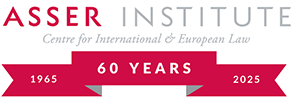Publications by Andrea Ott
- A. Ott, ‘EU Constitutional Boundaries to Differentiation? How to reconcile differentiation with integration’, in A.Ott and E.Vos (eds.), Fifty years of EU Integration: Foundations and Perspective (The Hague, TMC Asser Press 2009)
This contribution discusses the different forms of differentiation existing in EU law and policy, first by illustrating examples of furthering and harming integration and second by the analysing whether EU constitutional boundaries exists to restrict these forms of flexible cooperation. The paper questions whether primary law differentiation can be legally reviewed and whether supra-constitutional principles can restrain such differentiation.
- A. Ott, ‘New institutional actors in EU external relation: Trapped in a legal minefield between European and international law’, European Foreign Affairs Review (2008), pp. 515-540
The number of EU regulatory agencies has increased over the years. By fulfilling important administrative tasks in the EU, these agencies actively participate in international relations with third-country agencies or international organizations. Their actions are analysed against the backdrop of both the internal implications for the EU’s institutional balance and the consequences on EU external relations law and their status under international law.
- A. Ott, ‘Commentary on four freedoms (Grundfreiheiten) and accession treaties’, in F.Merli and S. Huster (eds.), Die Verträge zur Osterweiterung der Europäischen Union (Berlin, Berliner Wissenschaftsverlag 2008), pp. 129-178
Systematic legal commentary on the provisions of the accession treaty and acts of accession in the field of the four freedoms with a special emphasis on the restrictions for the free movement of workers from the CEEC. The contribution critically comments on these restrictions in the light of EU citizenship rights, the non-discrimination principle and the status of third country nationals from the EEA and Switzerland.
- A. Ot and R. Wessel, ‘The EU’s external relations regime: Multilevel complexity in an expanding Union’, in S. Blockmans and A.Lazowski (eds.), The European Union and its Neighbours (The Hague, TMC Asser Press 2006), pp. 19-59
This contribution analyses the basic elements of the EU external relations regime in the form of decisive case law on competences, direct effect of international agreements and effect of international customary law. It explains the fragmentation of EU external relations policies and highlights the impact of EU enlargement on new external relations initiatives such as the European Neighbourhood Policy.
- K. Inglis and A. Ott (eds.), The Constitution for Europe and an Enlarging Union: Unity in Diversity? (Groningen, Europa Law Publishing 2005)
Book publication resulting from a young researchers’ seminar in 2004 in Warsaw which tackles the constitutional debate in twelve contributions, institutional reform, national parliaments’ role, differentiation in EU law, the EMU and new member states, citizenship and Cyprus, impact of agriculture, European counter-terrorism, EU membership conditions, minority protection in EU and Turkey’s path of reform in light of its candidate status.
- A. Ott and K. Inglis (eds.), Handbook on European Enlargement (The Hague, TMC Asser Press 2002), 1116 pp.
Book publication with 52 authors offering a systematic commentary divided in three parts: (i) the description and commenting on the legal, political and historical background of the EU and the enlargement process; (ii) an overview on the introduction of international agreements into the legal order of EU, Member States and candidate countries; and (iii) a coverage of the approximation to and implementation of the acquis communautaire.
